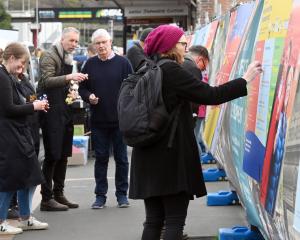Dunedin telegraph office employee Alois Lubecki organised this call on instructions from his boss, Charles Lemon (whose telegraph poles and cross-bars with their dozens of wires were soon called "Lemon trees").
But earlier, such was the telephone mania caused by regular reports of overseas progress during the previous year (by November 1877, New York was proudly proclaiming it had five telephones in operation), New Zealanders were desperate not to be left behind.
So began a series of first telephone calls, with Otago leading the charge.
The patrons at the Otago Agricultural and Pastoral Association show in late November 1877 flocked to see "the newly-invented telephone", which the Otago Witness observed "was being used by a number of persons to carry on conversations when at considerable distance from one another".
This surely would have been New Zealand's first demonstration of the telephone? But in its next issue, the newspaper toned down the excitement by explaining, "The telephone instruments themselves are very simple, consisting of two wooden tubes, one of which is placed at the mouth, the other at the ear".
A few weeks later, on January 15, 1878, Lawrence made a bid for a place in the telephonic sun.
Local watchmaker George Humphrey invited the Tuapeka Times to witness his new marvel, which the reporter described as "a wonderful contrivance".
Humphrey had used two mustard boxes with the lids and bottoms removed.
He had stretched thin parchment or sheepskin over the bottom of each box and connected them with cotton thread, "leaving the other end open for speaking through".
Those assembled were amazed to be able to talk and sing to each other through this contraption at a distance of 70ft (21m), although Humphrey claimed it worked at up to 80 yards (73m).
"Mr Humphrey put one of his little girls at one end, who sang Pop Goes the Weasel. The effect was astounding.
She was out in the back yard, while several persons were listening at the other end in the shop, and the melody was as clear and the words as distinct as if she had been in the same room.
"The public excitement over these "telephones" is hard to understand as reports from America and elsewhere were describing primitive but "real" telephones.
Not to be outdone by the country cousins in Lawrence, Dunedin was still in the fray and it was reported that "there has been quite a mania for telephones in the city.
Small boys take delight in manufacturing the `telegraph superseder' with empty pill boxes and cotton".
But was there any practical use for this new toy? The Dunedin printing firm of Fergusson and Mitchell is credited in some books with "the first use of a telephone in New Zealand".
In fact, it had simply copied the small boys and the Lawrence jeweller.
On January 25, 1878, the firm linked its office on one side of Princes St with its workshop on the other using two small ink tins joined by thread stretched across the street.
Then came the "proper" pioneering call between Dunedin and Milton.
For this experiment, a Dunedin "mechanician", Charles Henry (who went on to found an electrical engineering business in Princes St in 1882), made a "transceiver" (a combined telephone receiver and transmitter) based on information acquired from reading the Scientific American.
Not only was the call successful but it thrust Mr Henry into the limelight as, when his apparatus was set up in the Athenaeum, the hall was "thronged with persons eager to send and receive messages, and by means of resistance coils communication was established to a distance equal to close on 100 miles".
Around Roxburgh they will tell you that John Cargill, of Teviot Station, made New Zealand's first telephone call "sometime in 1877 when the postmaster's daughter called Cargill on the telephone" using a couple of instruments Alexander Graham Bell had given him.
The experts have not upheld this claim and at least one suggests Cargill used a Charles Henry machine, but some time after the historic Milton-Dunedin call.
After the Milton call - "not only could the words spoken at either end be clearly heard, but the difference in the tone of voices was easily distinguished.
The rapidity with which the questions were answered was simply marvellous" - the telephone took off and within weeks calls were being made around the Dunedin suburbs.
By March, a link-up was made from Christchurch to Dunedin and Cromwell.
Now, 130 years on, it looks as though the telephone may well be here to stay, including, sadly, its use by those clowns who ring you at dinner time to try to sell you something. - Jim Sullivan
- Jim Sullivan is a Dunedin historian.












